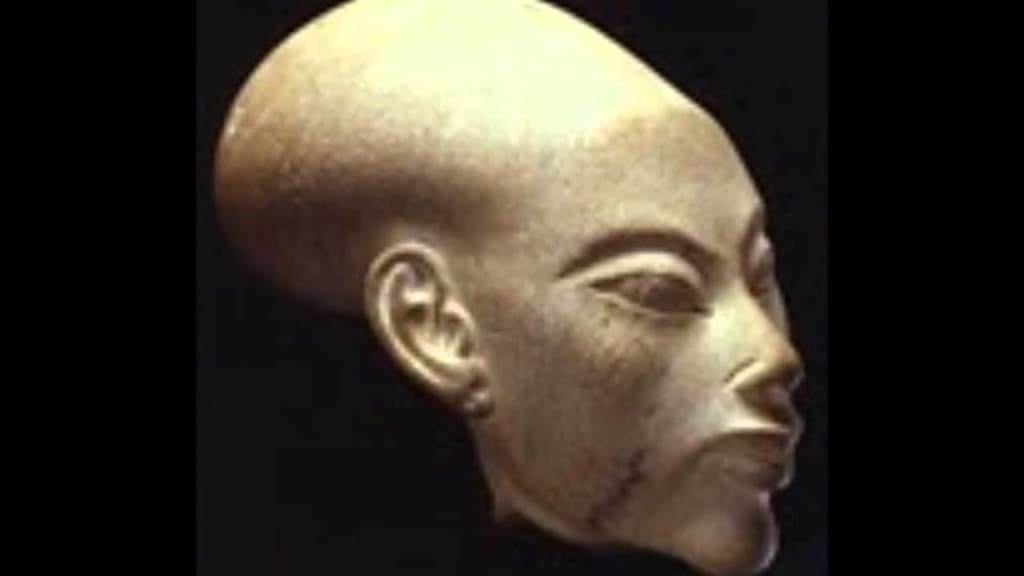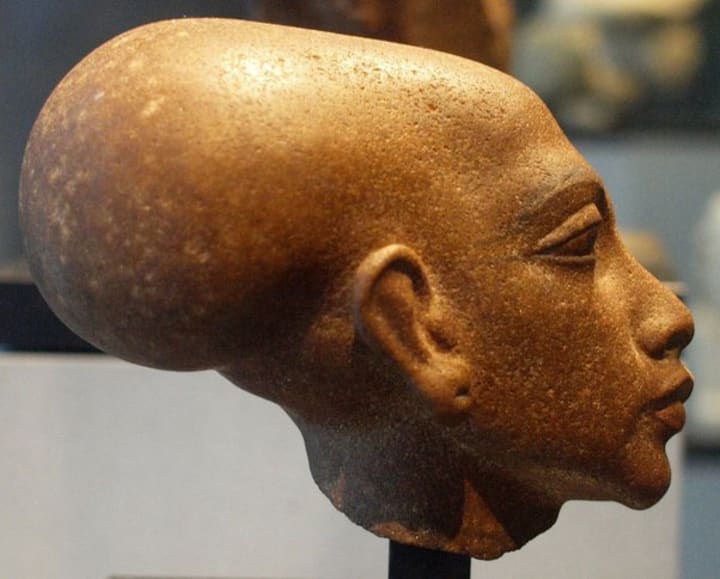Reason for the flat HEAD OF KING TUT.
Reason for the flat head of king TUT

We're back in the Human Evolution Lab with Dr. Robert Martin, who serves as curator emeritus of human evolution here at the Field Museum. Today, our focus will be on the practice of artificial head binding in ancient Egypt. So, Bob, could you start by explaining what artificial head binding entails? Absolutely. Throughout various cultures, we observe practices like foot binding in China, which leads to permanent physical changes. Typically, these practices are associated with the elite or specific groups in society. In the context of head binding, individuals intentionally shape a baby's skull from birth using various methods. This might involve placing a band across the crown or binding from front to back. A baby's skull is malleable during the first few years of life, but after that, its shape becomes relatively fixed, creating a distinctive appearance for life. EG: Is this achievable because the baby's cranial bones are not fused together at birth? Yes, exactly. The critical aspect is that if you examine a skull just before birth, humans have fontanelles, which are gaps in the skull.

These fontanelles provide flexibility because our babies have relatively large brains, making it necessary for them to pass through the mother's pelvis during childbirth. They initially face one direction but must turn 90 degrees during delivery, unlike most primates whose babies are born facing forward. These fontanelles allow for skull molding during the early years. EG: Does this practice affect fetal development or have any adverse effects on the baby's growth? As long as the practice doesn't reduce the cranial volume, which would be detrimental to the brain, there don't appear to be negative consequences. If you change the skull shape without altering the volume, it doesn't seem to have adverse effects. EG: That's reassuring. It's interesting to note that notable historical figures, such as King Tut, are associated with cranial deformation.
We have evidence beyond artistic representations, suggesting that King Tut indeed experienced cranial deformation. During our mummy project, we conducted CAT scans on several Egyptian mummies in our collection. Upon receiving a reconstruction by the Smithsonian, we noticed clear evidence of artificial cranial deformation. Notably, King Tut had an elongated skull shape, although it wasn't as extreme as some other cases. His father, Akhenaten, had a similar skull shape, and Nefertiti, his wife, likely shared this feature. Their six daughters also exhibited this head shape. Egyptologists have often described this as an artistic style, but it's hard to verify without the skulls. However, for Akhenaten and King Tut, we do have their skulls, confirming the presence of cranial deformation. Additionally, we observed this deformation in two other mummies—a 40-year-old woman and a priest's son named Minirdis. When we created a 3D print from the priest's son's skull, it became evident that a saddle-shaped depression existed on top of the skull and a counterpart beneath it. This suggests that priests intentionally practiced cranial deformation to achieve a distinct head shape, possibly over a thousand years after King Tut.
What's intriguing is the absence of written records or evidence of this practice among people in royal or high-society positions, like King Tut. Why do you think there's a lack of historical records regarding this practice? I believe this practice was kept secret and not intended for public knowledge. The goal was to select a small group of individuals and artificially alter their head shape to make them distinct from others. Disclosing such a practice would likely undermine its intended effect. Do you have any additional insights or examples related to head binding and its prevalence in ancient Egypt? One significant anthropological question revolves around why various human populations independently adopted the practice of binding their infants' heads. Cradle boarding, which is common in many societies, involves strapping babies to a board on the mother's back. This often involves securing the baby's head, which can lead to deformation over time.
However, this deformation tends to be irregular and asymmetrical. It would have been a short step from observing the accidental changes in head shape due to carrying babies this way to deliberately molding their skulls. The question remains: why did so many different populations, independently of one another, adopt this practice? There is no conclusive answer at this point. It's worth noting that some individuals have suggested extraterrestrial influences, linking head shapes to alien life forms. Films, for instance, depict aliens with cone-shaped heads. Do you have any comments to dispel these rumors that associate these practices with extraterrestrial influences? In some regions, such as Peru, there are skulls from Nazca and Paracas with extremely pronounced deformations. Some argue that these deformations are so extreme that they cannot be of human origin. Additionally, the Nazca lines, which are enormous geoglyphs, have led some to believe they can only be seen properly from outer space, leading to claims of extraterrestrial connections. More recently, someone claimed to have extracted genetic material from one of these Nazca skulls, suggesting it was not human DNA. However, these results haven't been published in reputable journals, so it's best not to put too much stock in these claims.
About the Creator
Enjoyed the story? Support the Creator.
Subscribe for free to receive all their stories in your feed. You could also pledge your support or give them a one-off tip, letting them know you appreciate their work.





Comments
There are no comments for this story
Be the first to respond and start the conversation.